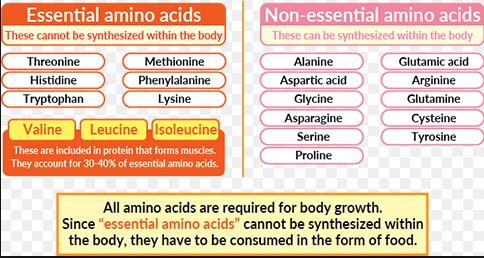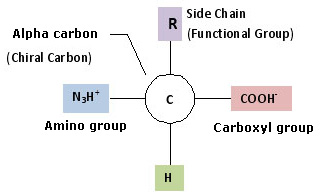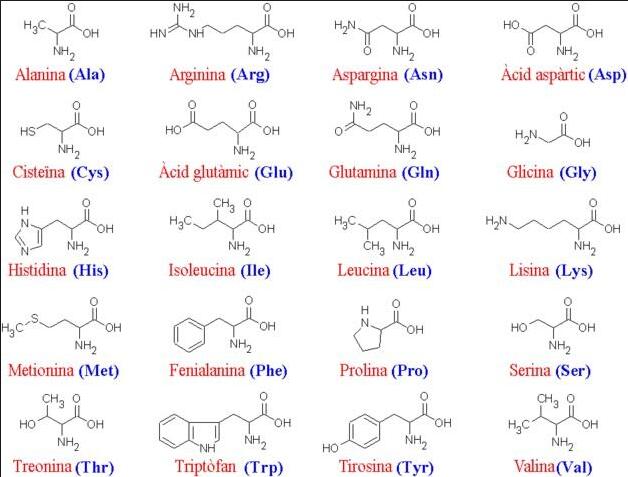Amino acids are a crucial, yet basic unit of protein,and they contain an amino group and a carboxylic group.They play an extensive role in gene expression processes,for instance,includes the adjustment of protein functions that facilitate messenger RNA (mRNA) translation (Scot et al., 2006).
In nature, over 700 types of amino acids have been uncovered. Almost all of them are α-amino acids. They have been discovered in: bacteria; fungi; algae; various other plants.
Amino acids also exist in free form. In particular, 20 very important amino acids are crucial for life as they contain peptides and proteins and are known to be the building blocks for all living things. After that,they are contained in living cells where they are used for protein synthesis. These amino acids are controlled by genetics. However,not all natural amino acids reside here. In fact, some very unusual amino acids are contained in plant seeds, where they are not crucial to the mature plant. However, they ward off predators and such for protection, giving off toxins or other unpleasant characteristics in order to help certain plant species survive.
In a word, amino acids are imperative for sustaining the health of the human body. They largely promote the:
• Production of hormones
• Structure of muscles
• Human nervous system’s healthy functioning
• Health of vital organs
• Normal cellular structure
If amino acids are deficient, then protein synthesis does not occur.
In addition to other positive body functions and growth, without alpha-amino acids, a person may experience fatigue, irritability, hormonal imbalances, and sometimes even depression.
To understand the abbreviations of amino acids, it is important to know why they have been abbreviated in the first place. This is to make them easy to identify and to shorten them in more manageable three-letter systems. Here we’ll take a look at the simplest amino acid, glycine. It is depicted as H-Gly-OH, with the «H» and the «OH» being «H2O», which represents the H2O at the time of amino acid condensing in order to form a peptide.

Another way to look at the three-letter abbreviation system is that it captures the amino acid residual state, which comprises proteins and peptides. In addiction,when this system was introduced, it was done so primarily to save space, rather than simplify amino acid names. It is important to know that, when a one-letter system is used, such as «G» for glycine, which is more commonly used nowadays, it is referring to synthesized peptides from the coded amino acids groups. However, this one-letter system is not to be referenced in other contexts.
How Amino Acids were Discovered
For the sake of a reference point, whether assumed or not, the amino acids we are focusing on here have resulted from protein hydrolysis. Therefore, throughout the centuries and the years,scientist found amino acids in a variety of ways.
Protein chemistries and the study of them are age-old, with some dating back thousands of years ago. Processes and technical applications,for instance,glue preparation, cheese manufacturing, and even the discovery of ammonia via the filtering, of dung or horn, occurred centuries ago. Moving forward in time to 1820, Braconnot prepared glycine directly from gelatin. He was attempting to uncover whether proteins acted like starch; they are decomposed acids with sugar production.
While progress was slow at that time, it has since gained plenty of speed, although the complicated processes of protein composition have not entirely been uncovered even to this day. However,since Braconnot first initiated such observations,many years have gone.
In looking to the future, scientists much more needs to discover about the analysis of amino acids, including finding new amino acids. The theory of protein constitution has a way to go in the field of biochemistry. Once that scientist accomplish this job – but only until then will our knowledge of amino acids and proteins be satisfied. Yet it is likely that day will not come anytime soon. Therefore,his all adds to the mystery, complexities, and strong scientific value of amino acids.
Classifications of Amino Acids
Experts classify amino acids based on a variety of features, including whether people can acquire them through diet. Accordingly, scientists recognize three amino acid types:
1. Nonessential
2. Essential
3. Conditionally essential
However, the classification as essential or nonessential does not actually reflect their importance, as all 20 amino acids are necessary for human health.Eight of these amino acids are essential (or indispensable) and cannot be produced by the body. They are:
• Leucine
• Isoleucine
• Lysine
• Threonine
• Methionine
• Phenylalanine
• Valine
• Tryptophan
Histidine is an amino acid that is categorized as semi-essential since the human body doesn’t always need it to properly function; therefore, dietary sources of it are not always essential. Meanwhile, conditionally essential amino acids aren’t usually required in the human diet, but do become essential under certain circumstances.
Finally, nonessential amino acids are produced by the human body either from essential amino acids or from normal protein breakdowns. Nonessential amino acids include:
• Asparagine
• Alanine
• Arginine
• Aspartic acid
• Cysteine
• Glutamic acid
• Glutamine
• Proline
• Glycine
• Tyrosine
• Serine
An additional amino acids’ classification depends upon the side chain structure, and experts recognize these five as:
• Cysteine and Methionine (amino acids containing sulfur)
• Asparagine, Serine, Threonine, and Glutamine (neutral amino acids)
• Glutamic acid and Aspartic acid (acidic); and Arginine and Lysine (basic)
• Leucine, Isoleucine, Glycine, Valine, and Alanine (aliphatic amino acids)
• Phenylalanine, Tryptophan, and Tyrosine (aromatic amino acids)
One final amino acid classification is categorized by the side chain structure that divides the list of 20 amino acids into four groups – two of which are the main groups and two that are subgroups. They are:
1. Non-polar
2. Polar
3. Acidic and polar
4. Basic and polar
For example, side chains having pure hydrocarbon alkyl or aromatic groups are considered non-polar, and these amino acids are comprised of Phenylalanine, Glycine, Valine, Leucine, Alanine, Isoleucine, Proline, Methionine, and Tryptophan.
Meanwhile, if the side chain contains different polar groups like amides, acids, and alcohols, they are classified as polar. Their list includes Tyrosine, Serine, Asparagine, Threonine, Glutamine, and Cysteine. If the side chain contains a carboxylic acid, the amino acids in the acidic-polar classification are Aspartic Acid and Glutamic Acid. Furthermore, if the side chain consists of a carboxylic acid and basic-polar, these amino acids are Lysine, Arginine, and Histidine.
Properties of Amino Acids
The properties of α-amino acids are complex, yet simplistic in that every molecule of an amino acid involves two functional groups: carboxyl (-COOH) and amino (-NH2).
As well, each molecule contains a side chain or an R group. And alanine is an example of a standard amino acid (which is used in the biosynthesis of proteins), However,each R group has very different properties and functions.
Amino acids are crystalline solids which have the capacity to dissolve in water. Meanwhile, they only dissolve sparingly in organic solvents, and the extent of their solubility depends on the size and nature of the side chain. Amino acids feature very high melting points – up to 200-300°C with other properties varying for each particular amino acid.
20 Amino Acids
Only twenty amino acids are most normally found as compounds of human peptides and proteins. These naturally occurring amino acids are used by cells so as to synthesize peptides and proteins. They are typically identified by this rather generic formula: H2NCHRCOOH.
Non-Polar,aliphatic residues
- Glycine(G/Gly).Slices DNA in order to produce different amino acids.One of the three most important glycogenic amino acids.
- Alanine(A/Ala).Important source of energy for muscle.One of the three most important glycogenic amino acids.The primary amino acid in sugar metabolism.Boosts immune system by producing antibodies.
- Valine(V/Val).Essential for muscle development.
- Leucine(L/Leu).Beneficial for skin,bone and tissue wound healing.
- Isoleucine(I/Ile).Necessary for the synthesis of hemoglobin.
- Proline(P/Pro).Critical component of cartilage acids in joint health,tendons and ligaments.Keeps heart muscle strong.
Aromatic residues
- Phenylalanine(F/Phe).Beneficial for healthy nervous system.It boosts memory and learning.
- Tyrosine(Y/Tyr).Precursor of dopamine,norepinephrine and adrenaline.Increases energy,improves mental clarity and concentration,can treat some depressions.
- Tryptophan(W/Trp)Necessary for neurotransmitter serotonin(synthesis).Effective sleep aid,due to conversion to serotonin.Reduces anxiety ans some forms of depression.Treats migraine headaches.Stimulates growth hormone.
Polar,non-charged residues
- Serine(S/Ser).One of the three most important glycogenic amino acids,the others being alanine and glycine.Maintains blood sugar levels,and boosts immune system.Myelin sheaths contain serine.
- Threonine(T/Thr).Required for formation of collagen.Helps prevent fatty deposits in liver.Aids in antibodies’
- Cysteine(C/Cys).Protective against radiation,pollution,and ultra-violet light.Detoxifier;necessary for growth and repair of skin.
- Methionine(M/Met).An antioxidant.Helps in breakdown of fats and aids in reducing muscle degeneration.
- Asparagine(N/Asn).One of the two main excitatory neurotransmitters.
- Glutamine(Q/Gln).Essential for helping to maintain normal and steady blood sugar levels.Helps muscle strength and endurance.Gastrointestinal function;provides energy to small intestines.
Positively charged residues
- Lysine(L/Lys).Component of muscle protein,and is needed in the synthesis of enzymes and hormones.It is also a precursor for L-carathine,which is essential for healthy nervous system function.
- Arginine(R/Arg). One of the two main excitatory neurotransmitters.May increase endurance and decrease fatigue.Detoxifies harmful chemicals.Involved in DNA synthesis.
- Histidine(H/His).Found in high concentrations in hemoglobin.Treats anemia;treat rheumatoid arthritis.
Negatively charged residues
- Aspartate(D/Asp).Increases stamina and helps protect the liver;DNA and RNA metabolism;immune system function.
- Glutamate(E/Glu).Neurotransmitter that is involved in DNA synthesis.





This Post Has One Comment
Niels Stuck
22 Apr 2020I discovered your blog site on google and check a few of your early posts. Continue to keep up the very good operate. Seeking forward to reading more from you later on!?